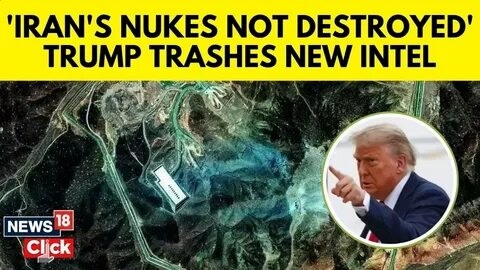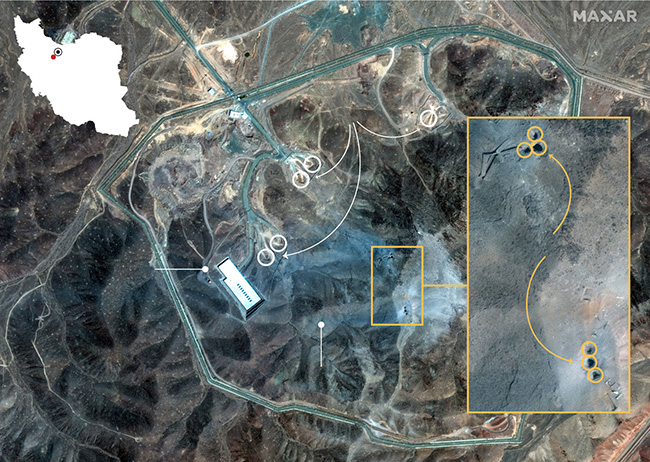
The US military strikes on three of Iran’s nuclear facilities last weekend did not destroy the core components of the country’s nuclear program and likely only set it back by months, according to an early US intelligence assessment that was described by seven people briefed on it, CNN informs.
The assessment, which has not been previously reported, was produced by the Defense Intelligence Agency, the Pentagon’s intelligence arm. It is based on a battle damage assessment conducted by US Central Command in the aftermath of the US strikes, one of the sources said.
The analysis of the damage to the sites and the impact of the strikes on Iran’s nuclear ambitions is ongoing, and could change as more intelligence becomes available. But the early findings are at odds with President Donald Trump’s repeated claims that the strikes “completely and totally obliterated” Iran’s nuclear enrichment facilities. Secretary of Defense Pete Hegseth also said on Sunday that Iran’s nuclear ambitions “have been obliterated.”
Two of the people familiar with the assessment said Iran’s stockpile of enriched uranium was not destroyed. One of the people said the centrifuges are largely “intact.” Another source said that the intelligence assessed enriched uranium was moved out of the sites prior to the US strikes.
“So the (DIA) assessment is that the US set them back maybe a few months, tops,” this person added.
The White House acknowledged the existence of the assessment but said they disagreed with it.
White House press secretary Karoline Leavitt told CNN in a statement: “This alleged assessment is flat-out wrong and was classified as ‘top secret’ but was still leaked to CNN by an anonymous, low-level loser in the intelligence community. The leaking of this alleged assessment is a clear attempt to demean President Trump, and discredit the brave fighter pilots who conducted a perfectly executed mission to obliterate Iran’s nuclear program. Everyone knows what happens when you drop fourteen 30,000 pound bombs perfectly on their targets: total obliteration.”
It is still early for the US to have a comprehensive picture of the impact of the strikes, and none of the sources described how the DIA assessment compares to the view of other agencies in the intelligence community. The US is continuing to pick up intelligence, including from within Iran as they assess the damage.
While US B-2 bombers dropped over a dozen of the bombs on two of the nuclear facilities, the Fordow Fuel Enrichment plant and the Natanz Enrichment Complex, the bombs did not fully eliminate the sites’ centrifuges and highly enriched uranium, according to the people familiar with the assessment.
Instead, the impact to all three sites — Fordow, Natanz and Isfahan — was largely restricted to aboveground structures, which were severely damaged, the sources said. That includes the sites’ power infrastructure and some of the aboveground facilities used to turn uranium into metal for bomb-making.
Jeffrey Lewis, a weapons expert and professor at the Middlebury Institute of International Studies who has closely reviewed commercial satellite imagery of the strike sites, agreed with the assessment that the attacks do not appear to have ended Iran’s nuclear program.
“The ceasefire came without either Israel or the United States being able to destroy several key underground nuclear facilities, including near Natanz, Isfahan and Parchin,” Lewis said, referring to the ceasefire between Israel and Iran that Trump announced on Monday. Parchin is a separate nuclear complex near Tehran.
“These facilities could serve as the basis for the rapid reconstitution of Iran’s nuclear program.”
 This is Iran’s Fordow Fuel Enrichment Plant. A satellite image from space imaging company Maxar Technologies, taken on June 22, shows external visible damage to the Fordow plant after US strikes. At least six impact craters are visible along a ridge running over the underground site pointing to the use of bunker-busting bombs.
This is Iran’s Fordow Fuel Enrichment Plant. A satellite image from space imaging company Maxar Technologies, taken on June 22, shows external visible damage to the Fordow plant after US strikes. At least six impact craters are visible along a ridge running over the underground site pointing to the use of bunker-busting bombs.
Source: Maxar Technologies, CNN analysis of satellite imagery
US officials believe Iran also maintains secret nuclear facilities that were not targeted in the strike and remain operational, according to two sources familiar with the matter.
Meanwhile, President Donald Trump was so pleased with the results of his decision to strike Iranian nuclear targets that he decided even before he’d left the Situation Room late Saturday that he was done using the U.S. military to help Israel, ‘The Washington Post’ reports.
He called Israeli Prime Minister Benjamin Netanyahu that night to tell him it was time for a ceasefire.
“Our U.S. military did what we needed to do,” Trump told Netanyahu, according to a senior White House official, speaking on the condition of anonymity to discuss sensitive conversations, in a telephone call with several news outlets Tuesday.
Netanyahu was not happy, the official said. But he understood that the president wanted to see a sharp turn toward diplomacy, and he ultimately agreed to a ceasefire.
read more in our Telegram-channel https://t.me/The_International_Affairs

 11:07 26.06.2025 •
11:07 26.06.2025 •






















